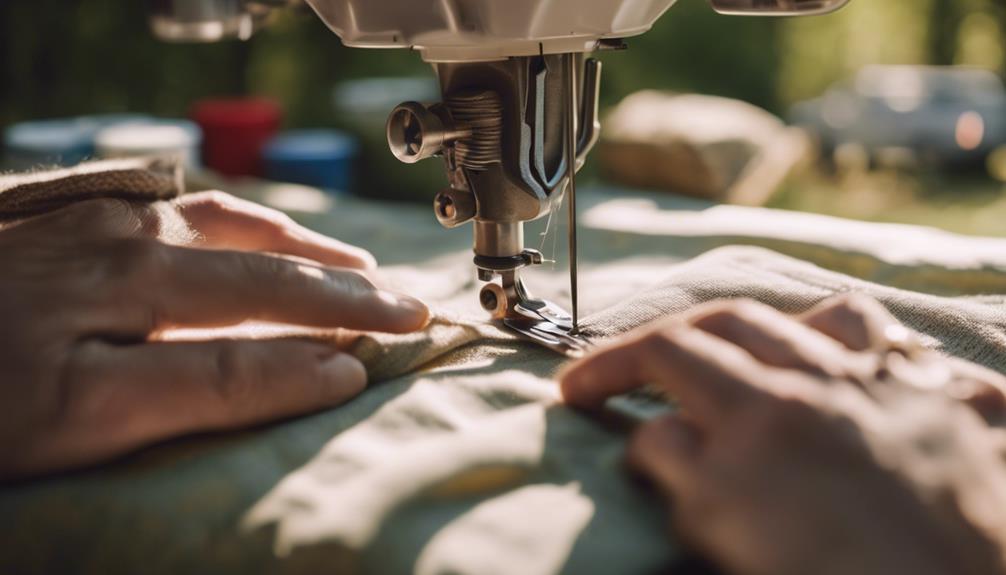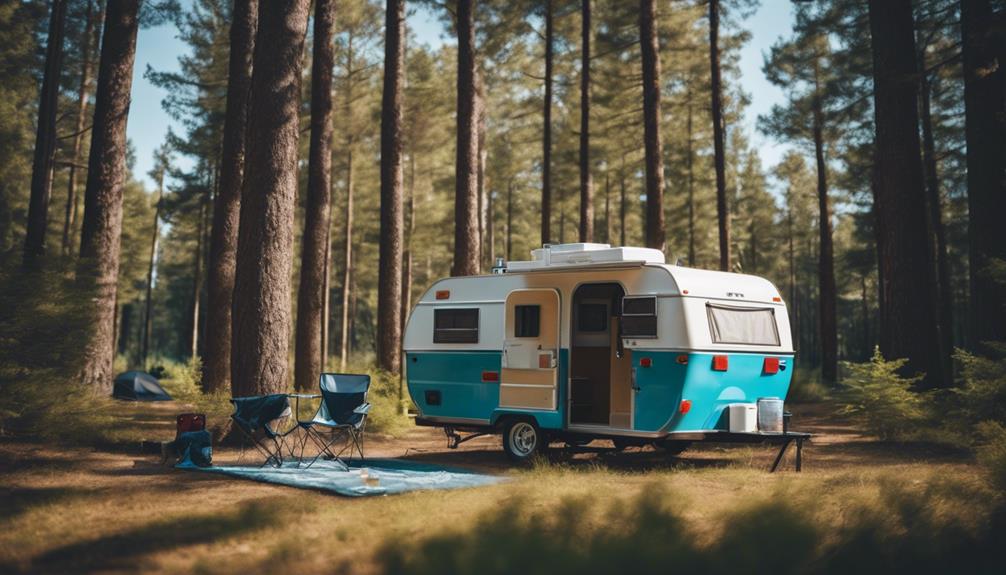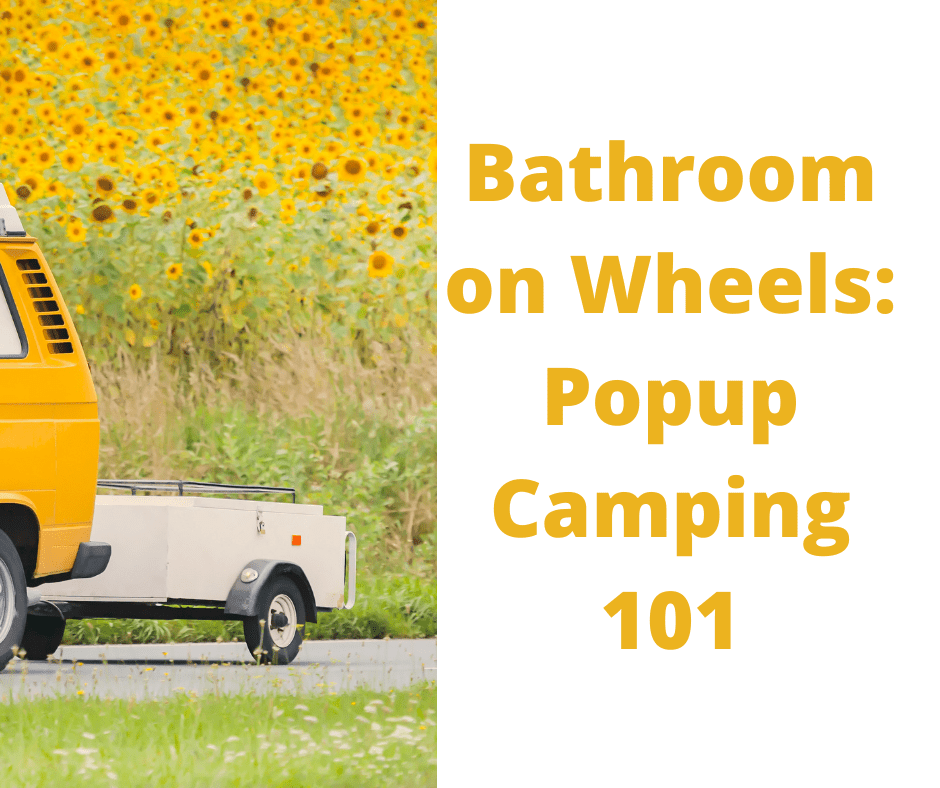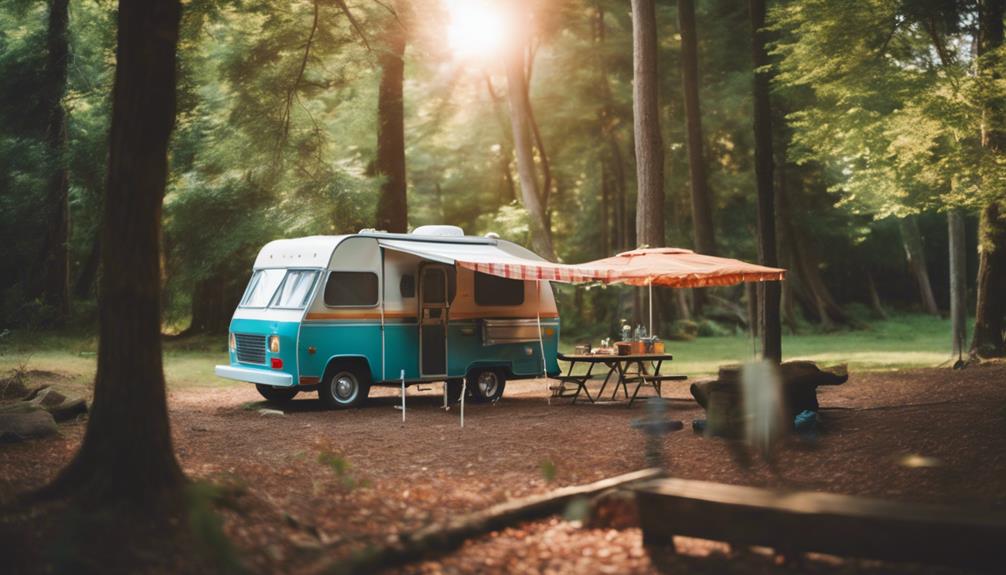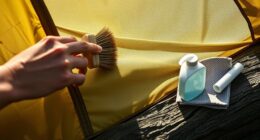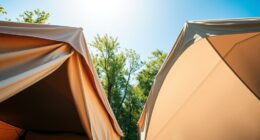Using a pop-up camper is straightforward and enjoyable. First, pick a level campsite and park your camper on stable ground. Set it up in about 20 minutes by extending the roof and pulling out the beds. Make certain to use leveling blocks to keep everything balanced. Connect any utilities, confirming you check for damage and secure proper connections. Pack essential gear like bedding, cooking supplies, and safety kits. Finally, maintain your camper regularly to guarantee it stays in great shape. If you want tips on gear or community resources, there's plenty more to explore!
Key Takeaways
- Choose a level campsite and use leveling blocks to stabilize your pop-up camper for a comfortable setup.
- Connect the camper's electrical cord and water hose securely, ensuring proper safety measures are followed to prevent damage.
- Pack essential gear such as bedding, cooking supplies, and a first-aid kit to ensure a smooth camping experience.
- Perform routine maintenance checks and clean the camper after each trip to prevent mold and ensure longevity.
Understanding Pop-Up Campers
Pop-up campers are a versatile and lightweight option for camping, combining the comfort of an RV with the convenience of a traditional tent. These towable RVs feature foldable walls and a tent-like structure, making them easy to store and transport.
You'll find that pop-up campers typically come equipped with basic amenities like sleeping bunks, a dinette, and storage space, along with a fresh water tank and sometimes a sink, enhancing your camping experience.
When setting up your pop-up camper, it's crucial to use leveling blocks to guarantee a stable base. This step helps prevent unnecessary wear on the camper and keeps everything inside from shifting.
The lightweight design means you can tow these campers with various vehicles, such as cars, minivans, and small SUVs, making them accessible for many campers, especially beginners.
Regular maintenance is key to getting the most out of your pop-up camper. By cleaning it and monitoring the tire pressure, you can extend its lifespan, which can last up to 15 years with proper care. Understanding these basics will help you enjoy your new camping adventure!
Benefits of Pop-Up Camping
Experiencing the comforts of pop-up camping allows you to enjoy a restful night's sleep while still being connected to nature. Whether you're a first-time camper or a seasoned adventurer, a pop-up camper offers several advantages that enhance your camping experience:
- Comfortable Sleeping: Built-in beds keep you off the ground for a better night's rest.
- Lightweight & Towable: Easy to tow with most vehicles, making travel hassle-free.
- Quick Setup: You can have your camper ready in about 20 minutes, so you can start enjoying your trip sooner.
- Basic Amenities: Enjoy electricity and fold-down furniture while still feeling close to nature.
When you verify that your camper is level, you'll further enhance your comfort and stability during your stay.
This combination of convenience and connection to the outdoors makes pop-up camping an ideal choice for anyone looking to explore the great outdoors without sacrificing too much comfort.
Essential Gear for Beginners

When you're just starting out with pop-up camping, having the right gear can make all the difference.
You'll want to focus on necessary camping equipment, a solid first-aid kit for safety, and some basic cooking essentials.
Let's break down what you'll need to guarantee a smooth and enjoyable experience in the great outdoors.
Necessary Camping Equipment
To guarantee a comfortable and enjoyable camping trip, you'll need to pack essential gear that covers bedding, hygiene, safety, and cooking. When using a pop-up tent camper, ensuring you have the necessary camping equipment can make all the difference.
Here's a concise list of items you should include:
- Bedding: Sheets, blankets, and pillows for a cozy night's sleep.
- Toiletries: Soap, shampoo, toothbrushes, towels, and toilet paper for hygiene.
- Cooking Essentials: Pots, cutting boards, knives, and coolers for meal prep.
- Portable Power Station: To keep your devices charged and ready.
Safety and First-Aid Kits
Packing a thorough safety and first-aid kit is essential for any camping trip, guaranteeing you're ready for minor injuries and unexpected emergencies. A well-stocked first-aid kit should include items like adhesive bandages, antiseptic wipes, and pain relievers. You should also carry a safety kit that features a fire extinguisher, flashlight, multi-tool, and an emergency whistle.
Regularly check your first-aid kit to guarantee all supplies are up-to-date and sufficient for your trip. Including a first-aid manual can provide quick reference in case of injuries.
To make your kit effective, consider personalizing it with specific medications or items needed for individuals in your group. Here's a quick reference table to help you organize your supplies:
| Essential Items | Purpose |
|---|---|
| Adhesive Bandages | Treat cuts and scrapes |
| Antiseptic Wipes | Clean wounds |
| Pain Relievers | Alleviate pain |
| Emergency Whistle | Signal for help |
| First-Aid Manual | Quick reference for emergencies |
Cooking Essentials Checklist
Having the right cooking essentials can make your camping experience enjoyable and stress-free, especially for beginners. To help you prepare delicious meals while you're out in nature, here's a checklist of must-have cooking gear:
- Portable stove or campfire grill: Perfect for versatile cooking options.
- Cooler: A 40-quart or larger model keeps perishables fresh.
- Multi-purpose knives: Include a chef's knife, paring knife, and a cutting board for safe food prep.
- Essential supplies: Don't forget spatulas, measuring cups, and a can opener for easy meal preparation.
With this checklist, you'll be well-equipped for a fun and efficient cooking experience in your pop-up camper.
Packing these essential supplies will guarantee you can whip up a variety of meals, making your outdoor adventure even more enjoyable.
Setting Up Your Camper
Position your camper on a level section of the campsite, taking care to assess the ground slope and nearby trees before unhooking your tow vehicle.
Once you've found the right spot, use a level tool to check that your camper is level side-to-side and front-to-back. If it's not, adjust with leveling blocks or plywood under the low side.
After unhitching, lower the tongue jack until the camper is stable, ensuring it remains level. It's essential to block the wheels with wood or chocks to prevent any movement during your stay.
Next, connect the camper's electrical cord to the campsite hookup. Before plugging it in, make sure to turn off the breaker for safety and check the cord for any visible damage.
Leveling Techniques and Tips

Achieving a perfectly level pop-up camper is essential for a comfortable and safe camping experience. To help you master leveling techniques, consider the following tips:
- Position your camper on a level area before unhitching.
- Identify the low side of the camper for adjustments.
- Use leveling blocks or plywood to raise the low side.
- Always check your level with a graduated level tool.
Once you've positioned your camper, raise the low side using leveling blocks or sturdy plywood. This guarantees stability both side-to-side and front-to-back. Avoid the temptation to eyeball it; instead, rely on your graduated level tool for an accurate reading.
After leveling, use stabilizer jacks to secure your camper and guarantee it remains steady during your stay.
Lastly, practice these techniques at home. The more familiar you're with leveling your pop-up camper, the quicker and more efficiently you'll set up at the campsite. With these tips in hand, you're well on your way to enjoying a hassle-free camping experience.
Connecting Utilities Safely
When you connect utilities to your pop-up camper, safety should be your top priority.
Start by following the electrical hook-up steps and then move on to the water connection guidelines to guarantee everything runs smoothly.
Keeping your connections secure and checking for damage can help you avoid headaches during your trip.
Electrical Hook-Up Steps
Before you plug in your pop-up camper, always turn off the breaker at the campsite to prevent any risk of electrical shock. Following this vital step will guarantee safe operation of your camper's electrical system.
Here's what you need to do:
- Inspect the electrical cord for visible damage.
- Connect the camper's 30 amp electrical cord securely into the campsite electrical post.
- Use a 25-foot extension cord if necessary, making sure it maintains the proper amperage.
- Double-check all connections for a tight fit to avoid power loss.
After you've made the connection, check that lights and appliances inside the camper are functioning properly.
Regularly inspecting your electrical cord and connections keeps your camping experience safe and enjoyable.
Water Connection Guidelines
After confirming your camper's electrical setup is safe, it's time to connect the water supply for a comfortable camping experience. Begin by using a clean drinking water hose designed for RVs to connect your camper's city water inlet to the campsite's water spigot. This guarantees you have safe drinking water.
To maintain consistent water pressure and protect your plumbing system, install a brass pressure regulator. If there's no spigot available, fill your onboard water tank until it overflows, then activate the water pump to use water inside the camper.
Always check your hose for visible damage before use to prevent leaks and contamination. Once you're set up, don't forget to manage your grey water. Attach a drain hose to the camper's grey water fitting, directing it to a grey water tank or bucket for proper disposal.
Here's a quick overview of the essential steps:
| Step | Action |
|---|---|
| Connect | Use a clean drinking water hose |
| Regulate | Install a brass pressure regulator |
| Fill | Activate the water pump if no spigot exists |
| Check | Inspect hoses for damage |
| Dispose | Direct grey water to a tank or bucket |
Maintaining Your Pop-Up Camper

Keeping your pop-up camper in prime shape requires regular cleaning, maintenance, and inspections to guarantee it's ready for your next adventure. By following some simple steps, you can make sure your camper remains in excellent condition.
Start by performing maintenance checks at least once a year. Inspect the roof for leaks, check seals, and test electrical and plumbing systems for any issues.
Don't forget to clean the canvas regularly to prevent mold and mildew buildup. This will extend its lifespan and maintain functionality.
For smooth operation, lubricate moving parts such as hinges and springs at least once a year.
Additionally, make it a habit to monitor tire pressure consistently, as this is vital for safe towing and ideal handling on the road.
After every trip, empty your camper, clean the interior, and make certain everything is dry before securely folding it up.
With these practices, your pop-up camper will be ready for many memorable adventures!
Storing Your Camper Properly
Properly storing your pop-up camper after each trip helps guarantee it stays in great condition and is ready for your next adventure.
Start by emptying all gear and supplies from the camper to confirm cleanliness and prevent mold growth. A clean interior is vital, so take the time to wipe down surfaces and dry everything thoroughly before folding up the camper.
Once clean, securely fold the camper tent and cover it with a tarp. This protects it from water damage and debris while stored. Choose a storage area that's dry and shaded to avoid sun damage, which can degrade materials over time.
Before you store the camper, conduct a thorough inspection of its components. Check the tires, canvas, and other essential parts for any necessary repairs or maintenance. Addressing these issues now can save you time and hassle later.
Community Tips and Resources

Joining online communities can provide you with invaluable tips and resources from fellow pop-up camper enthusiasts. Engaging with these groups can help you learn the ropes and build confidence in your camping skills.
Here are some great resources to take into account:
- Online forums and social media groups: Connect with experienced campers and gain insights from their personal experiences.
- Local camping clubs: Join a nearby club to meet like-minded individuals and participate in meetups for hands-on learning.
- Workshops and demonstrations: Many camping retailers offer events focused on setup and maintenance, perfect for beginners.
- Library resources: Check your local library for books and materials on camping and outdoor activities.
Frequently Asked Questions
What Is the Proper Way to Sleep in a Pop-Up Camper?
To sleep properly in a pop-up camper, fully extend and secure the beds, use a memory foam pad for comfort, stow your gear, check for drafts, and guarantee proper ventilation for fresh air.
How Fast Should You Drive With a Pop-Up Camper?
When towing a pop-up camper, you should drive between 55-65 mph for stability. Adjust your speed for weather and road conditions, and always check local laws regarding speed limits for towing trailers.
How Do I Make Pop up Camping Easier?
Want to make pop-up camping easier? Start by practicing setup at home. You'll uncover hidden challenges. Then, create a checklist, pre-make beds, and invest in helpful tools for a smoother, stress-free experience.
Are Pop-Up Campers Hard to Set Up?
Pop-up campers can be tricky to set up, especially for beginners. You'll need to level it correctly and manage several steps. Practicing at home can help you feel more confident when you're out camping.
Can I Use the Same Techniques for Using a Pop-Up Camper for Converting It Into a Food Trailer?
Yes, you can convert a popup camper into a food trailer. With the right techniques and modifications, you can transform the camper to meet food trailer regulations and requirements. Consider factors like size, layout, and equipment installation to ensure a successful conversion process for your convert popup camper into food trailer project.
Conclusion
As you embrace the adventure of pop-up camping, you'll find a balance between simplicity and comfort.
While the thrill of the great outdoors beckons, the cozy space of your camper offers a retreat.
Remember, each setup might feel intimidating at first, but soon it'll become second nature.
Just like the changing seasons, you'll adapt and grow, transforming challenges into cherished memories.
So, gear up, hit the road, and let the journey unfold!




